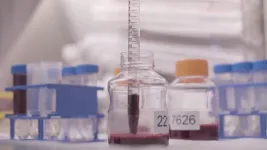(Press-News.org) Landfill gas, a mixture of gases produced when garbage breaks down within landfills, contains unwanted traces of siloxane compounds, which are chemical structures containing silicon and oxygen bonds and are found in various products like cosmetics and cleaning agents. These compounds can damage the equipment used to generate energy from landfill gas. In new research published in Environmental Progress & Sustainable Energy, investigators have identified low-cost adsorbents for siloxane removal from landfill gas.
The research highlights the potential of clinoptilolite (a naturally occurring mineral) and biochar (a type of charcoal) as cost-effective and environmentally friendly options and provides recommendations for modification techniques to enhance their performance.
“Repurposing waste materials in a circular economy is a key part of a sustainable future. Overcoming barriers such as cleanup of landfill gas is important to enable it,” said corresponding author John N. Kuhn, PhD, of the University of South Florida.
URL: https://onlinelibrary.wiley.com/doi/10.1002/ep.14534
Additional Information
NOTE: The information contained in this release is protected by copyright. Please include journal attribution in all coverage. For more information or to obtain a PDF of any study, please contact: Sara Henning-Stout, newsroom@wiley.com.
About the Journal
Environmental Progress & Sustainable Energy is a journal of the American Institute of Chemical Engineers (AIChE), focusing on current world problems in energy and environment. We help chemical engineers, scientists, and policy-makers stay on top of direction-setting technological advances on topics such as: climate change; sustainability and sustainable energy; air pollution; and remediation and treatment of solid or aqueous wastes.
About Wiley
Wiley is one of the world’s largest publishers and a trusted leader in research and learning. Our industry-leading content, services, platforms, and knowledge networks are tailored to meet the evolving needs of our customers and partners, including researchers, students, instructors, professionals, institutions, and corporations. We empower knowledge-seekers to transform today’s biggest obstacles into tomorrow’s brightest opportunities. For more than two centuries, Wiley has been delivering on its timeless mission to unlock human potential. Visit us at Wiley.com. Follow us on Facebook, X, LinkedIn and Instagram.
END
Scientists identify low-cost adsorbents for removing impurities from landfill gas
2025-01-06
ELSE PRESS RELEASES FROM THIS DATE:
CDC grant funds initiatives for breast cancer patients
2025-01-06
Weill Cornell Medicine has received a five-year, $2.3 million grant from the Centers for Disease Control and Prevention to improve equitable access to care, quality of life and survival outcomes for young people with all stages of breast cancer.
The grant will enable Weill Cornell Medicine to enhance care coordination for patients and caregivers to optimize support of physical, mental, emotional, social and spiritual needs, while offering culturally relevant resources and targeted interventions. The initiative ...
How can similar news stories influence financial markets? Here’s what investors need to know
2025-01-06
BINGHAMTON, N.Y. -- Have you ever noticed a swath of similar business news stories about a particular topic during a Google search, all of them appearing to be reported by different news outlets?
Why might a story on a news site in New York be so similar to one from a site in, for example, Wisconsin? It’s likely because the same media company owns them — and it’s become more commonplace nationwide as news outlets grapple with dwindling resources.
A new study co-authored by Flora Sun, assistant professor of accounting at Binghamton University’s School of Management, ...
Mixed signals: How the brain interprets social cues
2025-01-06
Imagine you’re at a dinner party, but you can’t smell the food cooking or hear the dinner bell. Sounds like a dream, right? What if it wasn’t?
“When we experience the world and interact with people, we use all our senses,” Cold Spring Harbor Laboratory Professor Stephen Shea says. “That’s true for animals and humans.” However, that’s not always the case in developmental disorders like autism. These conditions can affect how the brain processes incoming information, making it difficult to interpret the social cues that drive conversations, dates, and other ...
Climate extremes in 2024 ‘wreaking havoc’ on the global water cycle
2025-01-06
2024 was another year of record-breaking temperatures, driving the global water cycle to new climate extremes and contributing to ferocious floods and crippling droughts, a new report led by The Australian National University (ANU) shows.
The 2024 Global Water Monitor Report, involving an international team of researchers and led by ANU Professor Albert van Dijk, found rising temperatures are changing the way water moves around the planet, “wreaking havoc” on the water cycle.
“Rising ...
Acoustic sensors find frequent gunfire on school walking routes
2025-01-06
COLUMBUS, Ohio – A new study used acoustic sensors that detect the sound of gunfire to show how often children in one Chicago neighborhood are exposed to gunshots while walking to and from school.
Results showed that nearly two-thirds of schools in the Englewood neighborhood of Chicago had at least one gun incident within 400 meters (about one-quarter mile) of where children were walking home during the 2021-22 school year.
These findings suggest a need to redefine federal definitions of school gun violence to include indirect forms of violence that take place near schools, not only on school grounds, in order to more appropriately ...
New quantum sensing technology reveals sub-atomic signals
2025-01-06
Since the 1950s, scientists have used radio waves to uncover the molecular “fingerprints” of unknown materials, aiding in tasks as varied as scanning the human body with MRI machines and detecting explosives at airports.
These methods, however, rely on signals averaged from trillions of atoms, making it impossible to detect tiny variations between individual molecules. Such limitations hinder applications in fields like protein research, where small differences in shape control functionality and can determine the difference between health and disease.
Sub-Atomic Insights
Now, engineers at the University of Pennsylvania ...
Significant funding to ensure personalized treatments that work for rheumatoid arthritis
2025-01-06
In recent years treatment with powerful biologic and targeted synthetic therapies has changed the landscape for arthritis, but currently finding the right treatment for each person is a matter of trial and error. Only a proportion of patients with inflammatory arthritis respond to each expensive therapy, which results in unnecessary treatment and a long and often frustrating journey for patients, not to mention significant cost to the NHS.
University of Birmingham researchers have just been awarded £3.5 million funding from Johnson & Johnson to investigate ...
CryoSCAPE: Allen Institute scientists develop ‘suspended animation’ technique for blood draws that will aid research for underserved populations
2025-01-06
By Rachel Tompa, Ph.D
Your blood is a delicate mixture. Researchers and clinicians often use blood to learn what’s going on inside our bodies, in part because siphoning off a tube of blood is easier and less painful than taking biopsies of an internal organ.
But in some cases, it turns out that blood can be very different outside our bodies. When it comes to certain emerging research techniques, the clock starts ticking as soon as your blood hits the tube. As little as six to eight hours later, some aspects of your blood’s ...
Prime apple growing areas in US face increasing climate risks
2025-01-06
VANCOUVER, Wash. – Some of the most productive apple regions in America are facing big challenges from a changing climate, according to a Washington State University study.
Researchers analyzed over 40 years of climate conditions that impact the growth cycle of apple trees from bud break and flowering through fruit development, maturation and color development.
While many growing areas are facing increased climate risks, the top three largest apple producing counties in the U.S. were among the most impacted: Yakima in Washington, Kent in Michigan and Wayne ...
Extended Paxlovid may help some people with long COVID
2025-01-06
An up-close look at how patients respond to the drug at different times and doses adds nuance to a recent finding that Paxlovid does not work for long Covid.
An extended course of Paxlovid appears to help some patients with long Covid, according to a case series by UC San Francisco researchers that suggests this treatment option holds promise for some of those struggling with debilitating symptoms.
These results are at odds with recent research that has failed to show the antiviral can alleviate persistent symptoms of the disease. The authors said more study is needed to find out which patients may benefit from the drug and how long it should be given.
The ...




